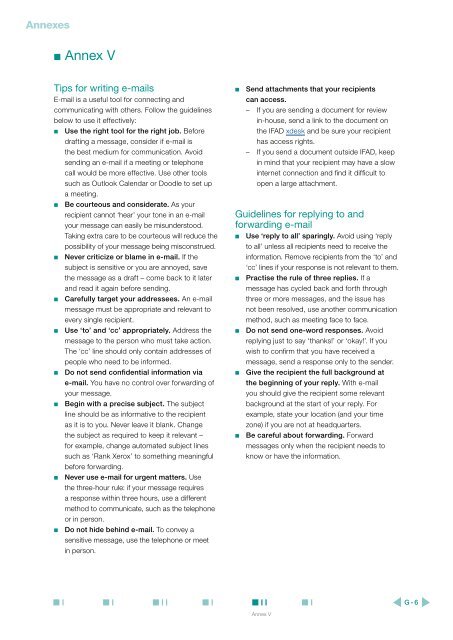Annexes - IFAD
Annexes - IFAD
Annexes - IFAD
You also want an ePaper? Increase the reach of your titles
YUMPU automatically turns print PDFs into web optimized ePapers that Google loves.
<strong>Annexes</strong><br />
J Annex V<br />
Tips for writing e-mails<br />
E-mail is a useful tool for connecting and<br />
communicating with others. Follow the guidelines<br />
below to use it effectively:<br />
<br />
<br />
<br />
<br />
<br />
<br />
<br />
<br />
<br />
Use the right tool for the right job. Before<br />
drafting a message, consider if e-mail is<br />
the best medium for communication. Avoid<br />
sending an e-mail if a meeting or telephone<br />
call would be more effective. Use other tools<br />
such as Outlook Calendar or Doodle to set up<br />
a meeting.<br />
Be courteous and considerate. As your<br />
recipient cannot ‘hear’ your tone in an e-mail<br />
your message can easily be misunderstood.<br />
Taking extra care to be courteous will reduce the<br />
possibility of your message being misconstrued.<br />
Never criticize or blame in e-mail. If the<br />
subject is sensitive or you are annoyed, save<br />
the message as a draft – come back to it later<br />
and read it again before sending.<br />
Carefully target your addressees. An e-mail<br />
message must be appropriate and relevant to<br />
every single recipient.<br />
Use ‘to’ and ‘cc’ appropriately. Address the<br />
message to the person who must take action.<br />
The ‘cc’ line should only contain addresses of<br />
people who need to be informed.<br />
Do not send confidential information via<br />
e-mail. You have no control over forwarding of<br />
your message.<br />
Begin with a precise subject. The subject<br />
line should be as informative to the recipient<br />
as it is to you. Never leave it blank. Change<br />
the subject as required to keep it relevant –<br />
for example, change automated subject lines<br />
such as ‘Rank Xerox’ to something meaningful<br />
before forwarding.<br />
Never use e-mail for urgent matters. Use<br />
the three-hour rule: if your message requires<br />
a response within three hours, use a different<br />
method to communicate, such as the telephone<br />
or in person.<br />
Do not hide behind e-mail. To convey a<br />
sensitive message, use the telephone or meet<br />
in person.<br />
<br />
Send attachments that your recipients<br />
can access.<br />
––<br />
If you are sending a document for review<br />
in-house, send a link to the document on<br />
the <strong>IFAD</strong> xdesk and be sure your recipient<br />
has access rights.<br />
––<br />
If you send a document outside <strong>IFAD</strong>, keep<br />
in mind that your recipient may have a slow<br />
internet connection and find it difficult to<br />
open a large attachment.<br />
Guidelines for replying to and<br />
forwarding e-mail<br />
<br />
<br />
<br />
<br />
<br />
Use ‘reply to all’ sparingly. Avoid using ‘reply<br />
to all’ unless all recipients need to receive the<br />
information. Remove recipients from the ‘to’ and<br />
‘cc’ lines if your response is not relevant to them.<br />
Practise the rule of three replies. If a<br />
message has cycled back and forth through<br />
three or more messages, and the issue has<br />
not been resolved, use another communication<br />
method, such as meeting face to face.<br />
Do not send one-word responses. Avoid<br />
replying just to say ‘thanks!’ or ‘okay!’. If you<br />
wish to confirm that you have received a<br />
message, send a response only to the sender.<br />
Give the recipient the full background at<br />
the beginning of your reply. With e-mail<br />
you should give the recipient some relevant<br />
background at the start of your reply. For<br />
example, state your location (and your time<br />
zone) if you are not at headquarters.<br />
Be careful about forwarding. Forward<br />
messages only when the recipient needs to<br />
know or have the information.<br />
G - 6<br />
Annex V

















